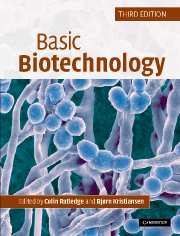Book contents
- Frontmatter
- Contents
- List of contributors
- Preface to the second edition
- Preface to the third edition
- Part I Fundamentals and principles
- Part II Practical applications
- Chapter 12 High-throughput screening and process optimisation
- Chapter 13 The business of biotechnology
- Chapter 14 Amino acids
- Chapter 15 Organic acids
- Chapter 16 Microbial polysaccharides and single cell oils
- Chapter 17 Environmental applications
- Chapter 18 Production of antibiotics by fermentation
- Chapter 19 Strategies of cultivation
- Chapter 20 Enzyme biotechnology
- Chapter 21 Recombinant proteins of high value
- Chapter 22 Insect and mammalian cell culture
- Chapter 23 Plant cell biotechnology
- Chapter 24 Biotransformations
- Chapter 25 Immunochemical applications
- Index
Chapter 24 - Biotransformations
Published online by Cambridge University Press: 05 June 2012
- Frontmatter
- Contents
- List of contributors
- Preface to the second edition
- Preface to the third edition
- Part I Fundamentals and principles
- Part II Practical applications
- Chapter 12 High-throughput screening and process optimisation
- Chapter 13 The business of biotechnology
- Chapter 14 Amino acids
- Chapter 15 Organic acids
- Chapter 16 Microbial polysaccharides and single cell oils
- Chapter 17 Environmental applications
- Chapter 18 Production of antibiotics by fermentation
- Chapter 19 Strategies of cultivation
- Chapter 20 Enzyme biotechnology
- Chapter 21 Recombinant proteins of high value
- Chapter 22 Insect and mammalian cell culture
- Chapter 23 Plant cell biotechnology
- Chapter 24 Biotransformations
- Chapter 25 Immunochemical applications
- Index
Summary
Introduction
Biotransformation deals with the use of biological catalysts to convert a substrate into a product in a limited number of enzymatic steps. The establishment of an efficient biotransformation process requires the extensive examination of factors affecting the development of optimal biocatalysts, reaction media and bioreactors (Fig. 24.1).
The chemical industry currently takes advantage of enzyme technology in various sectors, namely in the food, pharmaceutical and detergents sectors. An on-going trend towards the implementation of commercial processes based on the use of biocatalysts in other areas (e.g. polymers, fine and agricultural chemicals, and miscellaneous chemicals) is noticeable. It is foreseeable that in the near future the use of biocatalysts in these fields will be enhanced which, coupled to the already established bioprocesses, will further broaden the overall impact of biocatalysis in the chemical industry. When compared to equivalent chemical processes, bioprocesses are simpler, less demanding in raw materials and in energy, lead to higher quality products (i.e. with fewer impurities) and produce higher yields, lower the involvement of toxic wastes and decrease the emission of wastewater. Such features decrease production costs and, since bioprocesses easily comply with the stringent environmental legislation in highly regulated countries, these processes are given a competitive edge when matched up to conventional (chemical) methods. In many cases, near-term benefits will increase as the market penetration of the product and process continues to grow, leading to further cost reduction and performance improvements relative to competing products and processes.
- Type
- Chapter
- Information
- Basic Biotechnology , pp. 579 - 626Publisher: Cambridge University PressPrint publication year: 2006
- 4
- Cited by

